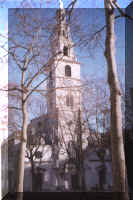|
In
1679 surveyors who examined the church decided it must be rebuilt,
and all of it was demolished in 1680 except for the tower. The
churchwardens made a contract in May 1680 with John Shorthose and
Edward Pearse, masons, to demolish the church and chancel and
rebuild it under the supervision of Sir Christopher Wren, Surveyor
of the King’s Works, preserving the battlements of 650 ft. for
reuse as well as the stone, bricks, and window ironwork. They were
to build the foundations, walls and pillars ready for the roof,
and set in the window ironwork. The new building was cased in
Portland Ashlar and the old materials used for the core of rubble
and brick.xcv
The new church of stone was completed in 1682, with work by the
carpenters Henry Pierson and John Green and the plasterer Robert
Powell. It was the only parish church by Wren to have an apse,
which was joined to the main body by a quadrant bay. Fine dial,
clock and portico and beautiful steeple, 116 ft. high containing 9
bells. Altar-piece, fine chancel paved with black and white
marble.xcvi
The
new church was paid for by the parishioners and gifts. In 1697 the
churchwardens and parishioners petitioned the Middlesex justices
for an additional poor-rate, which they obtained, as the parish
had spent nearly £15,000 on their new church and were nearly £4,000
in debt.xcvii
Gifts included £200 from Richard Shalmer, a parishioner, in 1698.xcviii
Despite
this recent expenditure on their church, the parish made a
proposal for a new church on the site of Grange Inn, near the
additional burial ground, which was accepted by the Commissioners
for Fifty New Churches in 1711 but was never carried out, possibly
because of the cost of buying out the freehold and leasehold
interests.xcix
Soon afterwards the Vestry decided on improvements to the existing
church, carried out in 1720. The tower was raised by 25 ft., and a
steeple 50 ft. added over the bells, designed by James Gibbs with
Townsend as mason; the steeple had 3 stages, Ionic, then (concave)
Corinthian, then Composite. The interior was sumptuously fitted,
the columns were fluted and the capitals gilded. A glory painted
by Kent was erected over the altar, but was taken down in 1725 by
order of the bishop following an allegation that the figure of St.
Cecilia was a portrait of the Stuart Pretender's wife with some of
her family. Carving on the altar was done by James Richards, and
there was also fretwork and wainscotting, and a S. gallery.
In
1866 there was an altar-piece of carved wainscot of Tuscan order.
The church seated 1,500, 350 of them free. 10 bells. Organ by
Smith, rebuilt by Robson.c
Repairs and redecoration by H. and P. Currey were carried out
1897-8, when the pews were lowered. The interior and furnishings
were destroyed by bombing in 1941. The church was rebuilt after
1945 as a central church for the R.A.F.; architect W.A.S. Lloyd of
W. Curtis Green, Sons and Lloyd; plasterwork of ceiling by Clark
and Fenn. Glass by Carl Edwards. Reopened Oct 1958.ci
Plate in 1685: 2 silver flagons, 4 silver bowls, 3 silver pattens.cii
References
|
|
lxxxviii
Guildhall MS. 9171/1, ff. 386-87v.
lxxxix
Guildhall MS. 9171/6, ff. 31v., 127v.
xciii
P.R.O., E 178/5482.
xciv
Pevsner, Buildings of Eng. City of Westm., ed.
Bradley, (forthcoming).
xcvii
Mdx. County Rec. Sess. Bks. 1689-1709, 176.
xcviii
P.R.O., C 93/46/28 [3rd inq].
xcix
Lond. Rec. Soc. xxiii. 149, 153, 156.
c
Mackeson's Guide (1866).
ci
Clarke, Lond. Chs. 176-7.
cii
Guildhall MS. 9537/20, p. 97. The church registers, at W.C.A.,
date from 1558.
|

